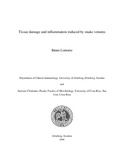| dc.description.abstract | Some characteristics of the local tissue damage and inflammatory reactions
induced by snake venoms were analyzed in a mouse model. Tissue damage was
studied by intravital, light, and electron microscopic techniques, and by the use of
biochemical markers. Detailed information on the early development and dynamics
of local tissue damage was obtained by intravital microscopy. Main alterations were
microvascular plasma leakage, hemorrhage, blood flow disturbances, thrombosis,
and myonecrosis. A new technique for the quantification of myonecrosis in vivo was
established, based on the principle of MTT reduction. The method was tested for its
usefulness in the evaluation of antibody-mediated neutralization of myotoxicity.
The inflammatory response to venom included early lymphopenia and
neutrophilia, thrombocytopenia, with edema and leukocyte extravasation at the site
of injection. A rapid plasma peak of IL-6 was induced by venoms, as well as by
purified muscle-damaging and hemorrhagic toxins, in response to cellular damage.
The effects of a purified hemorrhagic toxin on cultured endothelial cells were
studied. The toxin was not directly lytic to these cells even at high concentrations,
and caused moderate cell detachment due to its metalloproteinase activity,
suggesting that the endothelial cell damage in vivo occurs via an indirect mechanism,
probably initiated by proteolytic degradation of the basal lamina of microvessels.
Myotoxin II from Bothrops asper venom was shown to lyse a variety of cell
types in culture, including myoblasts and endothelial cells. This property was
exploited in a cytotoxicity assay for the evaluation of myotoxin neutralization.
Heparin was found to be a potent inhibitor of its cytolytic activity, by forming
complexes, held at least in part by electrostatic interactions. The ability of heparin to
neutralize several related non neurotoxic phospholipase A2 myotoxins present in
crotalid venoms, was not dependent on its anticoagulant effect. Thus, nonanticoagulant
heparin has a potential as a therapeutic aid, which should be further
evaluated. The structural characteristic of the binding interaction of heparin with
myotoxin II were analyzed, indicating that a hexasaccharide is the minimal heparin
chain size required, and that both N-sulfate and O-sulfate groups participate in the
binding. | es |



